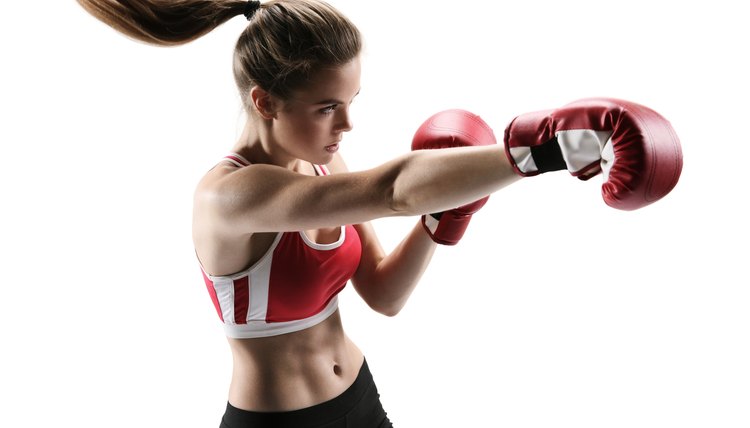List of Tae Bo Steps

Originally developed by Billy Blanks, a world karate champion and black belt, Tae Bo became popular in Hollywood in the 1980s. Blanks released his first Tae Bo DVD to the general public in 1998. Today, virtually all gyms offer some version of cardio boxing. As a form of exercise, Tae Bo and other cardio boxing formats utilize the punches and kicks used in a kickboxing ring to create a dynamic cardiovascular and strength-training workout that burns, on average, 500 calories per hour. The major steps in a class include hitting combinations and kicking combinations.
Defensive Stance
You will begin your cardio boxing class in defensive stance, with your feet shoulder-width apart and your right foot about a foot ahead of your left--and then your left ahead of your right, once you complete your combination on the right side of your body. You should be light on your feet, with your shoulders relaxed and your fists up to guard your face. The entire class (unless you are told otherwise) is done with a closed fist. Your fingers should be curled in, and your thumb rests along your pointer, middle and index finger. Once your form is prepared, you are ready to begin hitting.
Hits
The major hits in a cardio boxing class are the jab, punch (also called a cross), hook and upper-cut. The jab is the quickest hit. To jab, extend your front arm in direct line with your shoulder and twist your forearm at the contact point so that the palm part of your fist faces the floor. Recoil quickly to your starting position.
To punch, or cross, you will create power with your back leg. Pivot on your back foot as you twist your back leg at the hip toward your target, and extend your back arm fully so that your back fist aims toward your target. Recoil with control back to defensive stance.
To hook, you create a circular motion with your front hand. At your contact point, the bottom (palm) of your fist and your forearm should be parallel with the floor. Recoil at the end.
As with the punch, the upper-cut requires power from your back leg. Pivot in the same way you would for the punch, but this time, create a circular motion with your shoulder joint, drawing your fist behind your body, along your side, and ending with your fingers and knuckles facing toward the ceiling, as if you were punching an opponent under the chin. As with all punches, quickly recoil back to your starting position.
Kicks
Cardio boxing kicks engage the major muscle groups in your legs, allowing you to raise your heart rate and become stronger at the same time. The major kicks are front and side kicks. To do a front kick, begin again in defensive stance. Shift your weight to your front foot, draw your navel in toward your spine, and kick forward with your back leg in a knee-heel motion. For best form, kick out as if you were actually kicking an opponent and contacting him or her with your heel.
To side kick, stand facing a mirror. Shift your weight to your left foot and shift your upper body toward the left like a pendulum as you bend your right knee and bring your right outer thigh parallel to the ceiling. Kick out toward your right side in a knee-heel motion.
Writer Bio
April Redzic has been an AFAA-certified fitness instructor and a Chicago-based freelance writer since 2001, having written for "American Fitness," "Affluence," "Loyola" and "Spirit" magazines. The weekly women's fitness columnist for the Chicago Examiner, she teaches group fitness at DePaul University. She holds a bachelor's degree in English and anthropology from Loyola University Chicago and a master's in nonprofit administration from Notre Dame.
